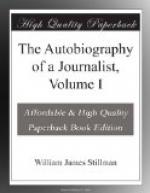I had seen, when last in England, the picture by Millais, “The Proscribed Royalist,” which gave me a suggestion of the treatment of a landscape which should be mainly foreground, such as I particularly delighted in. Hoping to find a woodland subject which admitted of this treatment, I went to pass the summer on the farm of an old uncle (where I had caught my first trout), knowing it to be heavily wooded. Of course when one goes out to look for a particular thing he never finds it, nor did I then find the tree subject I wanted, but I found a little spring under a branching beech and surrounded by mossy boulders, and, taking a canvas of my usual size,—25x30 inches,—I gave three months to painting it and carried it home still somewhat unfinished. It was an attractive subject, though not what I had wanted, and was hung in one of the best places in the Academy exhibition, making its mark and mine. It was absolutely unconventional, and the old stagers did not know what to say of a picture which was all foreground. There was much discussion, and, amongst the younger painters, much subsequent emulation; but it did not find a purchaser at my price—$250. Anything so thoroughly realistic that, as President Durand said, “The stones seemed to be, not painting, but the real thing,” puzzled the ordinary picture buyer; and the American Art Union, which was the principal buyer of the day, and the dernier ressort of the young artist, was managed by a committee of ordinary picture buyers. The picture gave rise to a hot discussion when exhibited, the old school of painters denouncing such slavish imitation of nature. As the negative photographic process had just then been introduced in America, I had the picture photographed, and a friend took a print of it to the head of the old school, without any explanation. My antagonist and critic looked at it carefully and exclaimed, “What is the use of Stillman making his pre-Raphaelite studies when we can get such photographs from nature as this!” As I had my brother’s generosity to fall back on, I was not obliged to sell, and the picture remained in my studio for two or three years. Later Agassiz saw it and was so delighted with its botany that I decided to give it to him; but when a fellow painter offered—when I was leaving again for Europe—to “raffle it off,” I allowed him to do so, and he appropriated the proceeds. I had made a rule of giving the pictures which were not sold in the exhibition to the person who had shown the finest appreciation of them,—a habit which did not contribute to pecuniary success, but which helped my amour propre, and I have always regretted not having sent that picture to Agassiz, who, in later years, became one of my best friends.
CHAPTER IX
SPIRITISM




